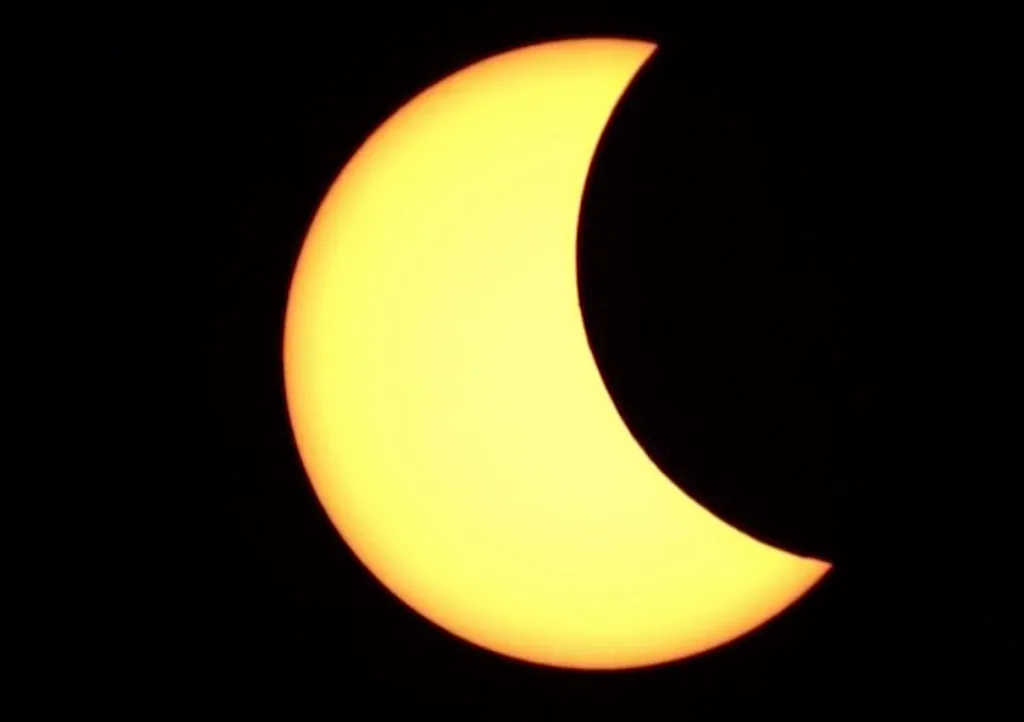
Eyes to the sky for Thursday morning's sunrise solar eclipse
Unpack those eclipse glasses and set an early alarm, because this 'ring of fire' eclipse promises to be an exceptional one.
Look to the eastern sky as the Sun rises Thursday morning. Be sure to be wearing your eclipse glasses at the time, however, so that you can take in the fantastic sight of the Moon passing in front of the Sun.
The last major astronomical event for Spring 2021 is the June 10 annular solar eclipse. As the Sun, Moon, and Earth line up for this event, the Moon's shadow will sweep across Earth's surface. It will follow a path that starts in Northern Ontario, passes across Nunavut and the Arctic Ocean to end in Siberia.
The unusual path of this eclipse is not the only thing that sets it apart. Because the Moon is near its farthest distance from Earth during the event, even at maximum, at the point of greatest eclipse, it will not completely block the Sun in a total solar eclipse. Instead, the Moon's disk will leave a 'ring of fire' around it, as it covers most of the Sun. This is known as an annular solar eclipse.
However, for most people watching, including nearly all from Canada, they will see this as only a partial eclipse.
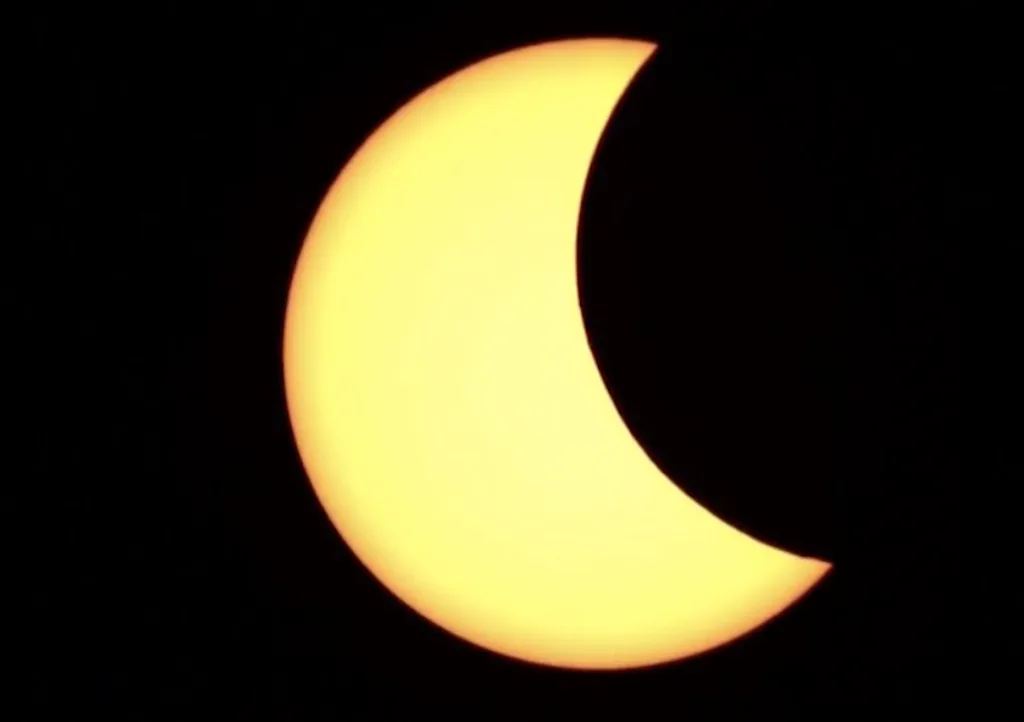
This image of the June 21, 2020 solar eclipse shows the partial phase of the eclipse. Credit: Hong Kong Space Museum
In Canada, the eclipse will be visible either at dawn or in the hours just after sunrise, but only for viewers in the northern and eastern parts of the country. For the rest of the nation, the eclipse starts and ends before the Sun even peeks above the horizon.
With the path of annularity being so remote, most viewers will see the Sun as a crescent due to the Moon blocking only part of it. For this reason, anyone watching the eclipse should wear some kind of protection over their eyes (perhaps the same mylar eclipse glasses you used in August 2017?). Alternatively, a pinhole camera will allow safe viewing of the eclipse.
Since this is annular eclipse, these precautions apply even for those watching from the path of annularity.
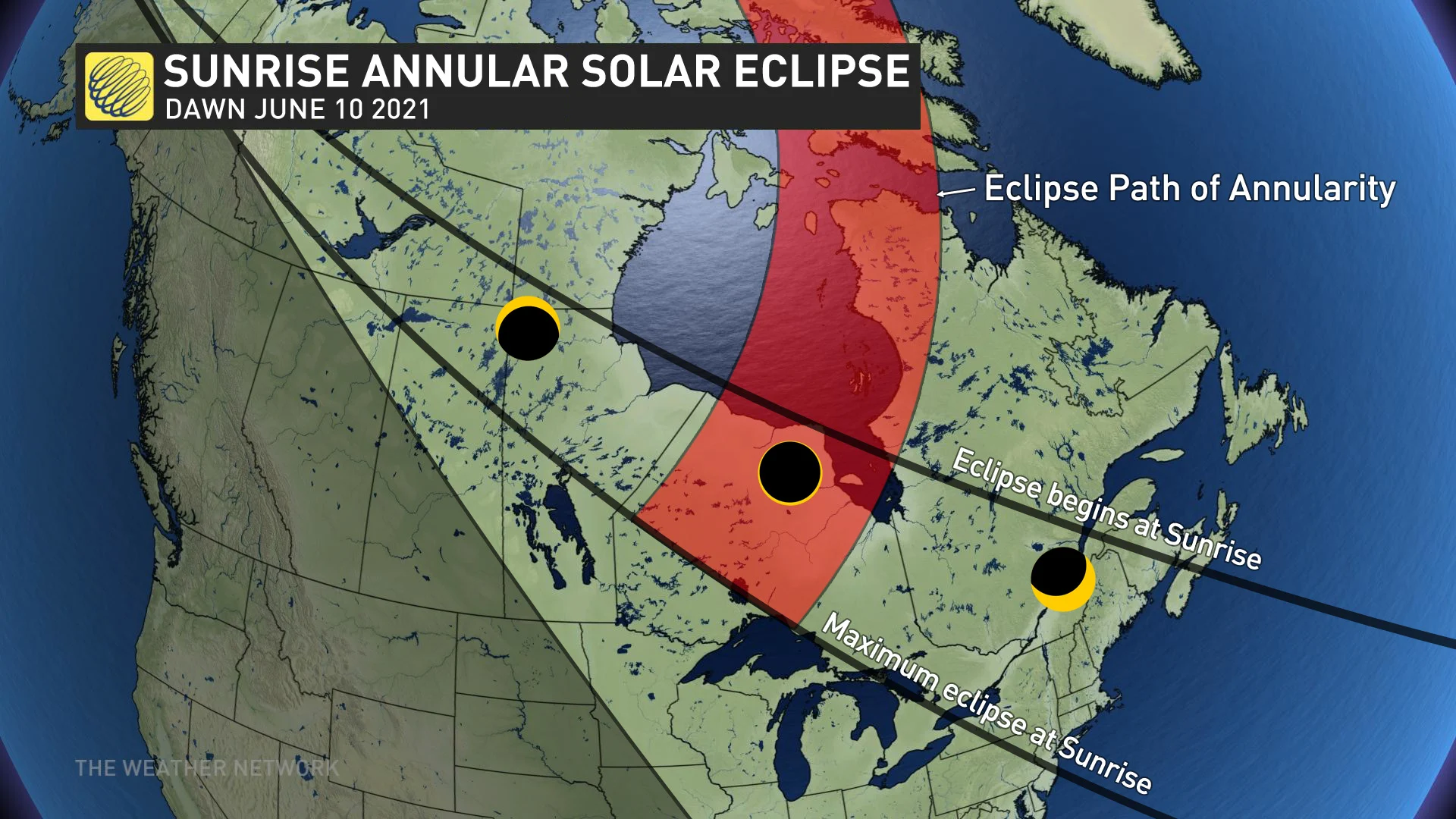
WILL SKIES BE CLEAR??
Weather is an essential factor that will influence everyone's chances of seeing this event. Even those positioned in the most advantageous location will have their view spoiled by cloudy skies. So, be sure to check your forecast to ensure that you'll have clear enough skies to see this spectacular sight.

If your skies are clouded over, but you still want to get up and watch it live, check out the available live streams.
If getting up that early is not enticing (or even possible), many of the live streams will be replayable later in the day. Plus, there's sure to be plenty of views of the eclipse on social media.
WHO WILL SEE IT??
The entire eclipse, from start to finish, will take just over two hours. How much of the eclipse you see and what part of the eclipse you see will depend on where you are watching.
The map below plots what the eclipse will look like for various locations across eastern and northern Canada, along with what time the eclipse peaks at that location.
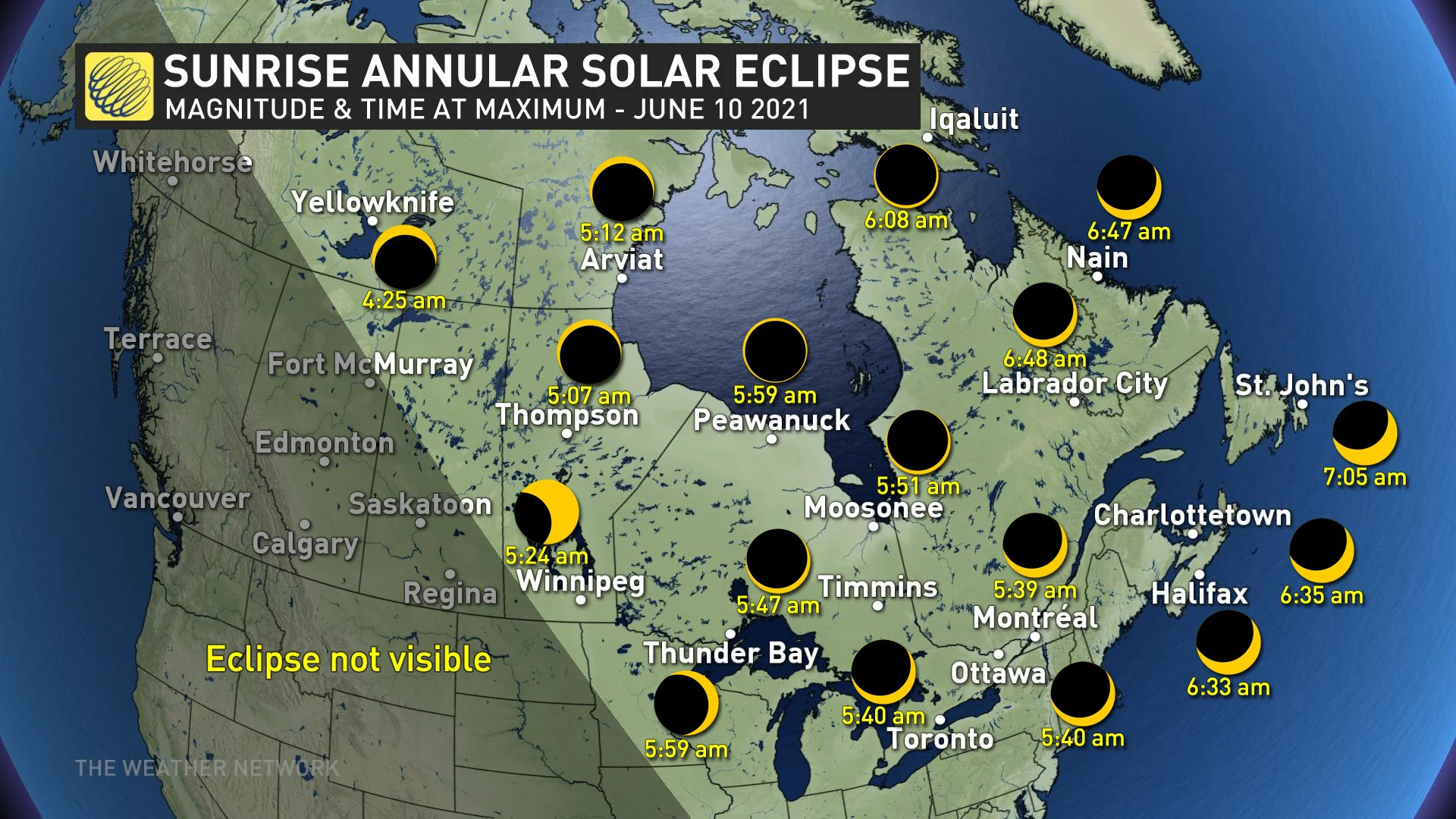
For those in Atlantic Canada, the eclipse begins after sunrise. Other than in the far north, this region of the country offers the best view of the entire event.
St John's: sunrise 5:03 a.m. NDT, eclipse 6:05-8:10 a.m., peaks at 7:05 a.m.
Charlottetown: sunrise 5:20 a.m. ADT, eclipse 5:37-7:38 a.m., peaks at 6:35 a.m.
Halifax: sunrise 5:28 a.m. ADT, eclipse 5:36-7:35 a.m., peaks at 6:33 a.m.
Labrador City: sunrise 5:02 ADT, eclipse 5:48-7:51 a.m., peaks at 6:48 a.m.
Nain: sunrise 4:34 ADT, eclipse 5:46-7:52 a.m., peaks at 6:47 a.m.
Viewers in Quebec and Ontario will see the eclipse starting right at sunrise. In the southern regions of these provinces, the farther west the viewer is, the further along the eclipse will be at that time. Note the timing: if the starting time of the eclipse matches the timing of sunrise, the eclipse is already in progress as the Sun begins to rise.
Monteal: sunrise 5:05 a.m. EDT, eclipse 5:05-6:39 a.m., peaks at 5:39 a.m.
Ottawa: sunrise 5:14 a.m. EDT, eclipse 5:14-6:39 a.m., peaks at 5:40 a.m.
Toronto: sunrise 5:35 a.m. EDT, eclipse 5:35-6:46 a.m., peaks at 5:40 a.m.
The farther north one is in Quebec and Ontario, and thus closer to the path of annularity, the earlier the Sun will rise. This will offer a better and longer view of the eclipse.
Timmins: sunrise 5:23 a.m. EDT, eclipse 5:23-6:46 a.m., peaks at 5:47 a.m.
Moosonee: sunrise 5:07 a.m. EDT, eclipse 5:40-6:51 a.m., peaks at 5:51 a.m.
Peawanuck: sunrise 5:03 a.m. EDT, eclipse 5:03-6:58 a.m., peaks at 5:59 a.m.
Skywatchers from Timmins and Moosonee will see some of the greatest partial eclipse views of the event. Meanwhile, Peawanuck, from within the path of annularity, will see the complete 'ring of fire' eclipse.
Far western Ontario and southern Manitoba are special cases during this event. The Sun begins rising only four minutes before the eclipse reaches its maximum for those regions of the country. Thus, viewers will likely miss the maximum and only see the second half of the eclipse.
Thunder Bay: sunrise 5:55 a.m. EDT, eclipse 5:55-6:49 a.m., peaks at 5:59 a.m.
Winnipeg: sunrise 5:20 a.m. CDT, eclipse 5:20-5:55 a.m., peaks at 5:24 a.m.
Those farther west will not see the eclipse because it will have ended before the Sun begins to rise. However, communities farther north will still see it due to the unusual path the shadow is taking during this eclipse.
Thompson: sunrise 4:48 a.m. CDT, eclipse 4:48-6:04 a.m., peaks at 5:07 a.m.
Arviat: sunrise 3:41 a.m. CDT, eclipse 4:15-6:11 a.m., peaks at 5:12 a.m.
Yellowknife: sunrise 3:44 a.m. MDT, eclipse 3:44-5:22 a.m., peaks at 4:25 a.m.
The best view from Canada will likely be in Iqaluit and farther north.
Iqaluit: sunrise 2:18 a.m. EDT, eclipse 5:06-7:13 a.m., peaks at 6:08 a.m.
Resolute: sun up all day, eclipse 4:32-6:36 a.m. CDT, peaks at 5:33 a.m.
Watch below: Learn how to make a pinhole viewer to watch a solar eclipse safely
TYPES OF SOLAR ECLIPSES
Back in August of 2017, a spectacular total solar eclipse was visible from a narrow strip of the United States. Along this path, the Moon appeared to completely cover up the Sun's disk for several minutes. During this time, while the Sun was safely tucked away behind the Moon, it was even safe to remove your eclipse glasses! This allowed viewers to catch a glimpse of the beautiful solar corona before having to put the glasses back in place for when the first beads of sunlight poked out from behind the limb of the Moon.
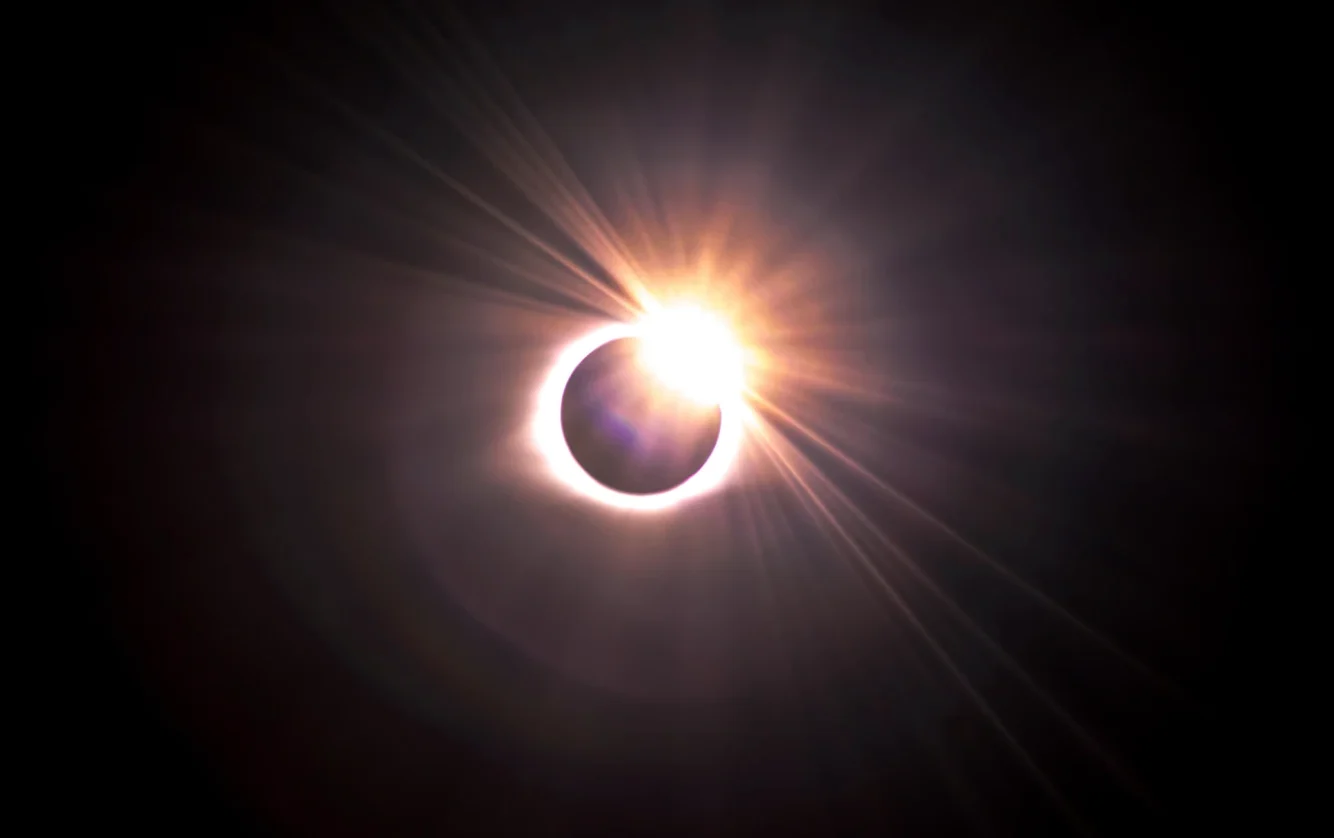
This view of the August 2017 solar eclipse was captured from Scottsville, Kentucky. Credit: Justin Dickey, Unsplash
Elsewhere during the event, such as up here in Canada, only a partial eclipse was visible. The farther from the path of totality you were, less of the Sun was covered by the Moon, even at maximum eclipse.
Viewers had to wear their eclipse glasses or use a pinhole camera or other indirect way to watch the whole time. With only part of the Sun covered up, looking at it for any significant amount of time, even just a few moments, would risk damage to your eyes.
An annular solar eclipse looks so different from a total solar eclipse due to the Moon's distance and thus its apparent size. As the Moon travels around the Earth, it follows an elliptical orbit. So, sometimes it is closer to Earth, and other times it is farther from Earth. If an eclipse happens when the Moon is closer to Earth than usual, it appears large enough to completely cover the Sun's disk. If the Sun, Moon and Earth line up when the Moon is farther away, though, the Moon doesn't block all of the Sun's light. Instead, it leaves a ring of the Sun's disk around it.
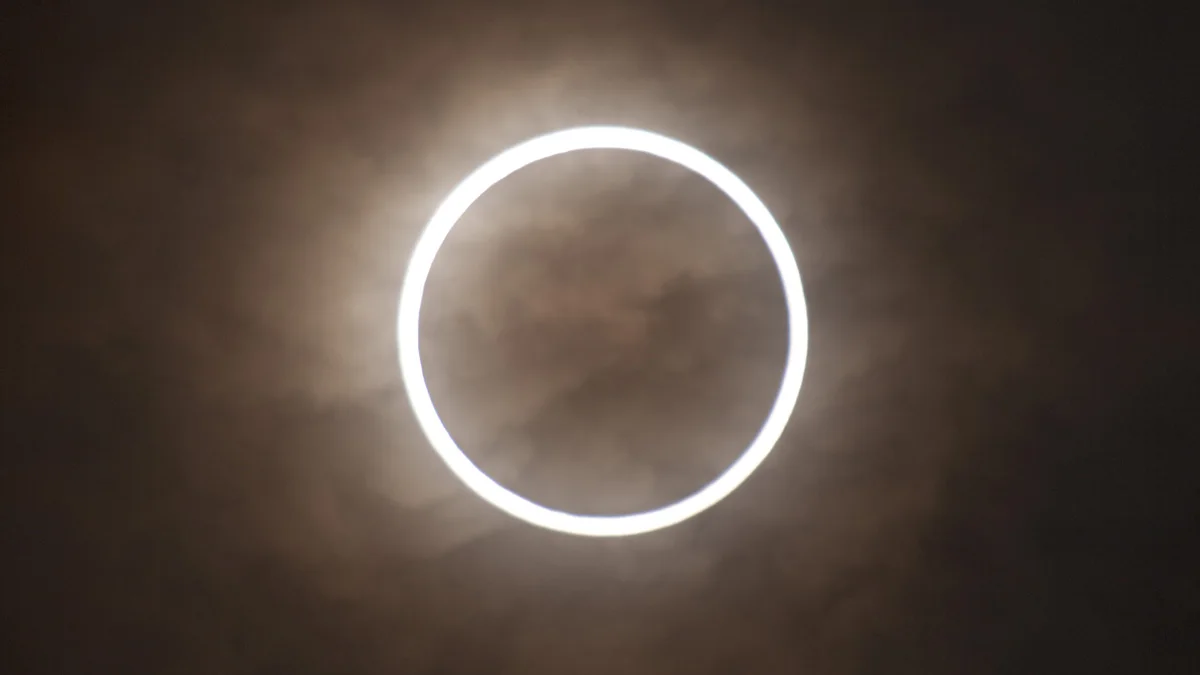
The annular solar eclipse of 2012. Credit: Nakae/Wikimedia Commons
There is a brief safe moment to look at a total solar eclipse without eye protection, right when the Sun is completely covered by the Moon. In contrast, there is no safe time to do so during an annular eclipse.











